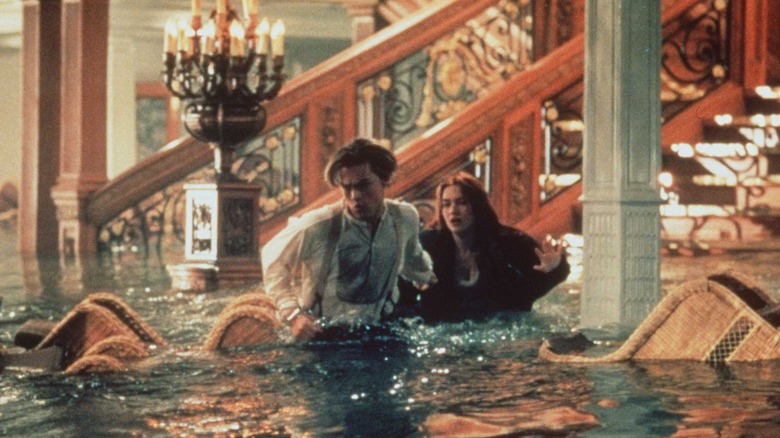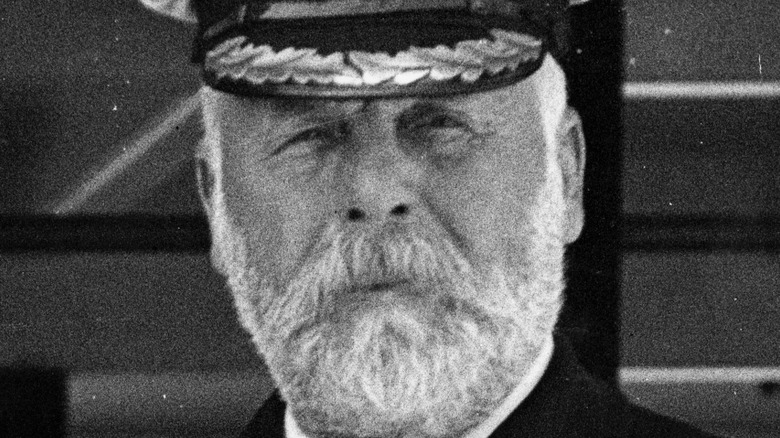How Historically Accurate Is The Movie Titanic?
One of the high-water marks of 1990s cinema was 1997's "Titanic." The movie netted director James Cameron his first-ever Academy Awards, for both Best Picture and Best Director (per the Academy's website), became the first movie to gross over $1 billion (per The Atlanta Journal-Constitution), and launched the careers of stars Leonardo DiCaprio and Kate Winslet.
The film is also a work of historical fiction, which is to say, though the main plot is fictitious, the broader context of the film takes place within actual, documented history. There really was a ship named Titanic, it really did strike an iceberg and sink in the North Atlantic Ocean, and hundreds of people genuinely died.
However, Cameron took a few liberties with known history in putting his version of the Titanic story onto the film. Further, in some cases what actually happened is either fully unknown or in dispute, and what Cameron put on the screen may not match up with the actual reality of what happened that night.
Jack and Rose are not real
The narrative that drives the plot of "Titanic" is the story of Jack Dawson (Leonardo DiCaprio) and Rose Dewitt Bukater (Kate Winslet). The tale of two star-crossed lovers — Jack a poor but ambitious vagabond traveling in third-class, Rose a first-class passenger who's hampered by her family's expectations — gave the audience characters to relate to while the broader story of the Titanic played out in the background.
Jack and Rose were not real, according to History, and indeed, full lists of the names of passengers who sailed on the ship are available online, via Titanic Facts. A close inspection of one of those lists reveals that no one bearing either of those names was on the vessel, nor was there anyone named Cal Hockley, the villainous older man to whom Rose was expected to be married.
It bears noting that it's impossible to say whether or not any actual third-class and first-class passengers fell in love with each other on that brief voyage the way Jack and Rose did; if they did, their story is lost to history.
Some other characters are (mostly) real
As History notes, Cameron wanted to make certain that the narrative of Jack and Rose was juxtaposed with the stories of real people who sailed on the Titanic, and in particular, first-class passengers. Many of those stories are depicted on the screen more or less exactly as their stories are believed to have played out, although in some cases the stories of the surviving passengers don't always mesh perfectly with the on-screen portrayals.
Nevertheless, a couple of passengers' stories, as depicted on the film, are believed to be mostly real. For example, Margaret Brown (Kathy Bates) was a real first-class passenger who persuaded the captain of her under-filled lifeboat to go back and rescue more passengers. Similarly, the film depicts two first-class passengers, an aged man and woman, lying in their bed in an embrace as the waters surround them. Those were Isador and Ida Strauss, according to Cinema Blend, who refused special treatment and chose to die with the hundreds of other passengers.
Various members of the crew were also depicted, with varying degrees of accuracy. For example, the death of Captain Edward Smith (pictured above) might not have happened as depicted in the film. Specifically, the movie shows him standing at the bridge and going down with the ship, when in actuality, he may have jumped into the ocean in an attempt to save other passengers.
A popular astronomer helped James Cameron
In an example of a rather extreme devotion to minutiae — indeed, details that the overwhelming majority of viewers wouldn't notice — an astronomer helped director James Cameron sort out a mistake he'd made depicting the stars in the sky. Specifically, as Mental Floss notes (and spoilers for a 22-year-old movie follow), a scene depicts Rose floating on a piece of wood, the stars in the cloud-free sky glistening behind her. Leave it to an astronomer to have a fine attention to detail, and as it turns out, Neil deGrasse Tyson (pictured above), did just that, noting that the position in the stars in the sky that night would have been different than how they were depicted on the screen.
Unfortunately, Tyson only noticed it while watching a special re-release 15 years after the fact. Nevertheless, he sent Cameron a "snarky" (as the director described it) email. "I said 'All right, send me the right stars for that exact time and I'll put it in the movie." Sure enough, when the film was re-released in 2012 in 3D, and indeed, for all subsequent printings and re-releases, the scene has depicted the accurate star map provided by Tyson.



